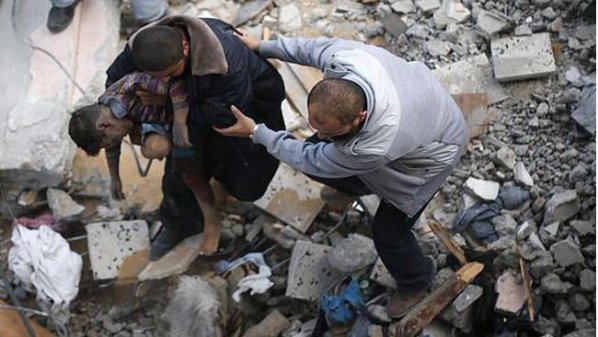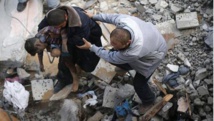Tens of thousands of civilians are believed to remain in Raqa, seized by IS three years ago and turned into the jihadist group's de facto Syrian capital.
The alliance, known as the Syrian Democratic Forces (SDF), broke into Raqa on June 6 after a months-long operation to surround it and have since seized about a quarter of the city.
Fighting has been fierce but residents like Shaabu have been stopped from leaving by IS, which has been accused of using civilians as human shields.
"We couldn't get out... They wouldn't let us," Shaabu, 35, told AFP in Jazra, a western suburb of Raqa, after finally escaping on Tuesday.
Holding his small daughter in his arms, Shaabu described how his family and other residents were trapped in the western Raqa neighbourhood of Al-Daraiya.
"If we stepped outside we were targeted by snipers. They shot at me once when me and friends went out to fetch water," he said.
The families had gathered supplies but were running low and still had to risk leaving their homes, especially to get water.
The streets were quiet on Tuesday and some of the smaller children -- free to roam without fear of being targeted by the jihadists -- were out when they were spotted by SDF fighters.
- Apocalyptic landscape -
"Our friends (the SDF fighters) saw the kids and started gesturing to them, and one of the children came and told us it was safe for us to get out," Shaabu said.
"If IS fighters had seen us, we wouldn't have been able to leave. Anyone spotted by IS members are returned to their homes."
The families managed to make it to Jazra, where AFP found them sitting on mats in the shade of a concrete building.
Some smiled, relieved at having escaped the city, and some of the women wore colourful abaya robes and headscarves, abandoning the severe black clothing imposed by the jihadists.
Others were still nervous or distraught, some of the women wiping tears from their eyes.
At the edge of Al-Daraiya from where they escaped, SDF fighters could be seen on the frontline of the battle, firing from inside a building through holes in its concrete walls.
In the distance the landscape was apocalyptic -- crumbling concrete tower blocks, collapsed roofs, black smoke rising. The streets were abandoned except for a pair of bodies decomposing in the sun.
Backed by air strikes from the US-led coalition that launched raids against IS in Iraq and Syria nearly three years ago, SDF forces have seized two eastern and two western districts of Raqa.
From those neighbourhoods, they are bearing down on Raqa's Old City, the most densely populated area.
UN rights chief Zeid Ra'ad Al Hussein said Wednesday that up to 100,000 civilians are trapped in Raqa, with many "terrified and confused about where they can seek refuge".
SDF Commanders say the advance has been slow in recent days as IS fighters put up heavy resistance.
"The more we progress in the city, the more we get attacked with car bombs and snipers and heavy weapons," said Zana Kobane, an SDF field commander.
--------------------------------------------------------------------------------------------------------------------
The alliance, known as the Syrian Democratic Forces (SDF), broke into Raqa on June 6 after a months-long operation to surround it and have since seized about a quarter of the city.
Fighting has been fierce but residents like Shaabu have been stopped from leaving by IS, which has been accused of using civilians as human shields.
"We couldn't get out... They wouldn't let us," Shaabu, 35, told AFP in Jazra, a western suburb of Raqa, after finally escaping on Tuesday.
Holding his small daughter in his arms, Shaabu described how his family and other residents were trapped in the western Raqa neighbourhood of Al-Daraiya.
"If we stepped outside we were targeted by snipers. They shot at me once when me and friends went out to fetch water," he said.
The families had gathered supplies but were running low and still had to risk leaving their homes, especially to get water.
The streets were quiet on Tuesday and some of the smaller children -- free to roam without fear of being targeted by the jihadists -- were out when they were spotted by SDF fighters.
- Apocalyptic landscape -
"Our friends (the SDF fighters) saw the kids and started gesturing to them, and one of the children came and told us it was safe for us to get out," Shaabu said.
"If IS fighters had seen us, we wouldn't have been able to leave. Anyone spotted by IS members are returned to their homes."
The families managed to make it to Jazra, where AFP found them sitting on mats in the shade of a concrete building.
Some smiled, relieved at having escaped the city, and some of the women wore colourful abaya robes and headscarves, abandoning the severe black clothing imposed by the jihadists.
Others were still nervous or distraught, some of the women wiping tears from their eyes.
At the edge of Al-Daraiya from where they escaped, SDF fighters could be seen on the frontline of the battle, firing from inside a building through holes in its concrete walls.
In the distance the landscape was apocalyptic -- crumbling concrete tower blocks, collapsed roofs, black smoke rising. The streets were abandoned except for a pair of bodies decomposing in the sun.
Backed by air strikes from the US-led coalition that launched raids against IS in Iraq and Syria nearly three years ago, SDF forces have seized two eastern and two western districts of Raqa.
From those neighbourhoods, they are bearing down on Raqa's Old City, the most densely populated area.
UN rights chief Zeid Ra'ad Al Hussein said Wednesday that up to 100,000 civilians are trapped in Raqa, with many "terrified and confused about where they can seek refuge".
SDF Commanders say the advance has been slow in recent days as IS fighters put up heavy resistance.
"The more we progress in the city, the more we get attacked with car bombs and snipers and heavy weapons," said Zana Kobane, an SDF field commander.
--------------------------------------------------------------------------------------------------------------------









 Home
Home Politics
Politics











